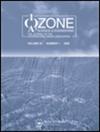Quantitative evaluation of the inactivation effect of ozonated water on SARS-CoV-2 based on corrected CT values
IF 1.4
4区 环境科学与生态学
Q3 ENGINEERING, ENVIRONMENTAL
引用次数: 1
Abstract
ABSTRACT There are many issues in the evaluation protocols based on CT (mg min/L) values, which have been used to assess the germicidal effect of highly oxidative and unstable ozonated water. The major problems include the carryover of culture medium components in virus inactivation assays and the reaction volume ratio between the virus suspension and ozonated water. Furthermore, it is essential to correct the CT value with the decay curve of dissolved ozone under the same conditions as the inactivation assay. In this study, these concerns were reexamined to obtain quantitative CT values. Severe acute respiratory syndrome coronavirus-2 (SARS-CoV-2) inactivation test using ozonated water prepared from pure water was assessed by determining the corrected concentration time (CCT) values. Moreover, a possible inactivation mechanism of SARS-CoV-2 was discussed with the aid of findings from this study and previous reports. The findings revealed that the CCT value required for 99.95% inactivation of SARS-CoV-2 with ozonated water was 0.97 mg·min/L. To quantitatively evaluate the SARS-CoV-2 inactivation test, the virus purification procedure during the pretreatment and the CT value correction using a dissolved ozone decay curve obtained under the same condition as the inactivation test were demonstrated to be essential. We proposed a possible mechanism of SARS-CoV-2 inactivation with ozonated water. Amino acids such as tyrosine, tryptophan, methionine, cysteine, and histidine in the SARS-CoV-2 spike protein are susceptible to oxidative attack by the ozone dissolved in water. This attack may induce structural destruction of the spike protein and inhibit its binding to the angiotensin converting enzyme 2 (ACE2) receptor, an essential host receptor for viral infection, resulting in viral inactivation and contributing to infection suppression.基于校正CT值的臭氧化水对SARS-CoV-2灭活效果定量评价
基于CT (mg min/L)值的评价方案在评价高氧化不稳定臭氧化水的杀菌效果时存在许多问题。主要问题包括病毒灭活试验中培养基成分的残留以及病毒悬浮液与臭氧化水的反应体积比。此外,在与灭活实验相同的条件下,用溶解臭氧的衰减曲线校正CT值是必要的。在本研究中,我们重新检查了这些问题,以获得定量的CT值。通过测定校正浓度时间(CCT)值,评价用纯水制备的臭氧水灭活SARS-CoV-2试验。此外,结合本研究结果和以往报道,讨论了SARS-CoV-2可能的失活机制。结果表明,臭氧化水灭活SARS-CoV-2所需的CCT值为0.97 mg·min/L。为了定量评价SARS-CoV-2灭活试验,证明了预处理过程中的病毒纯化程序和在与灭活试验相同条件下获得的溶解臭氧衰减曲线的CT值校正是必不可少的。我们提出了臭氧化水灭活SARS-CoV-2的可能机制。SARS-CoV-2刺突蛋白中的酪氨酸、色氨酸、蛋氨酸、半胱氨酸和组氨酸等氨基酸容易受到溶解在水中的臭氧的氧化攻击。这种攻击可能会导致刺突蛋白的结构破坏,并抑制其与血管紧张素转换酶2 (ACE2)受体(病毒感染的重要宿主受体)的结合,导致病毒失活并有助于感染抑制。
本文章由计算机程序翻译,如有差异,请以英文原文为准。
求助全文
约1分钟内获得全文
求助全文
来源期刊

Ozone: Science & Engineering
环境科学-工程:环境
CiteScore
5.90
自引率
11.10%
发文量
40
审稿时长
2 months
期刊介绍:
The only journal in the world that focuses on the technologies of ozone and related oxidation technologies, Ozone: Science and Engineering brings you quality original research, review papers, research notes, and case histories in each issue. Get the most up-to date results of basic, applied, and engineered research including:
-Ozone generation and contacting-
Treatment of drinking water-
Analysis of ozone in gases and liquids-
Treatment of wastewater and hazardous waste-
Advanced oxidation processes-
Treatment of emerging contaminants-
Agri-Food applications-
Process control of ozone systems-
New applications for ozone (e.g. laundry applications, semiconductor applications)-
Chemical synthesis.
All submitted manuscripts are subject to initial appraisal by the Editor, and, if found suitable for further consideration, to peer review by independent, anonymous expert referees.
 求助内容:
求助内容: 应助结果提醒方式:
应助结果提醒方式:


